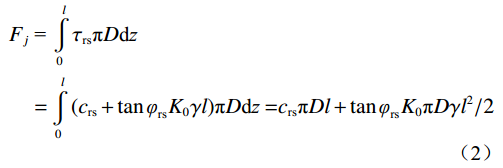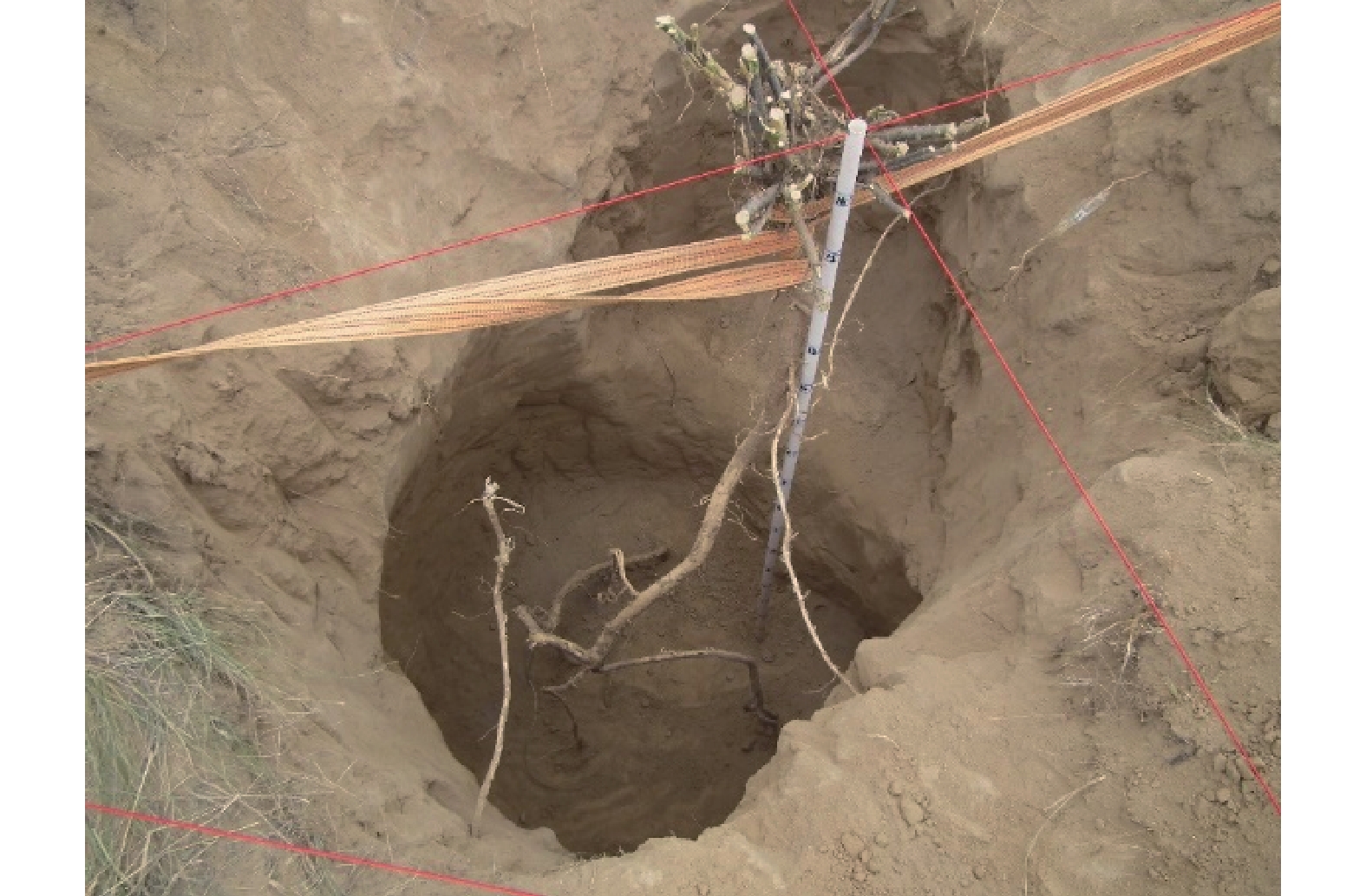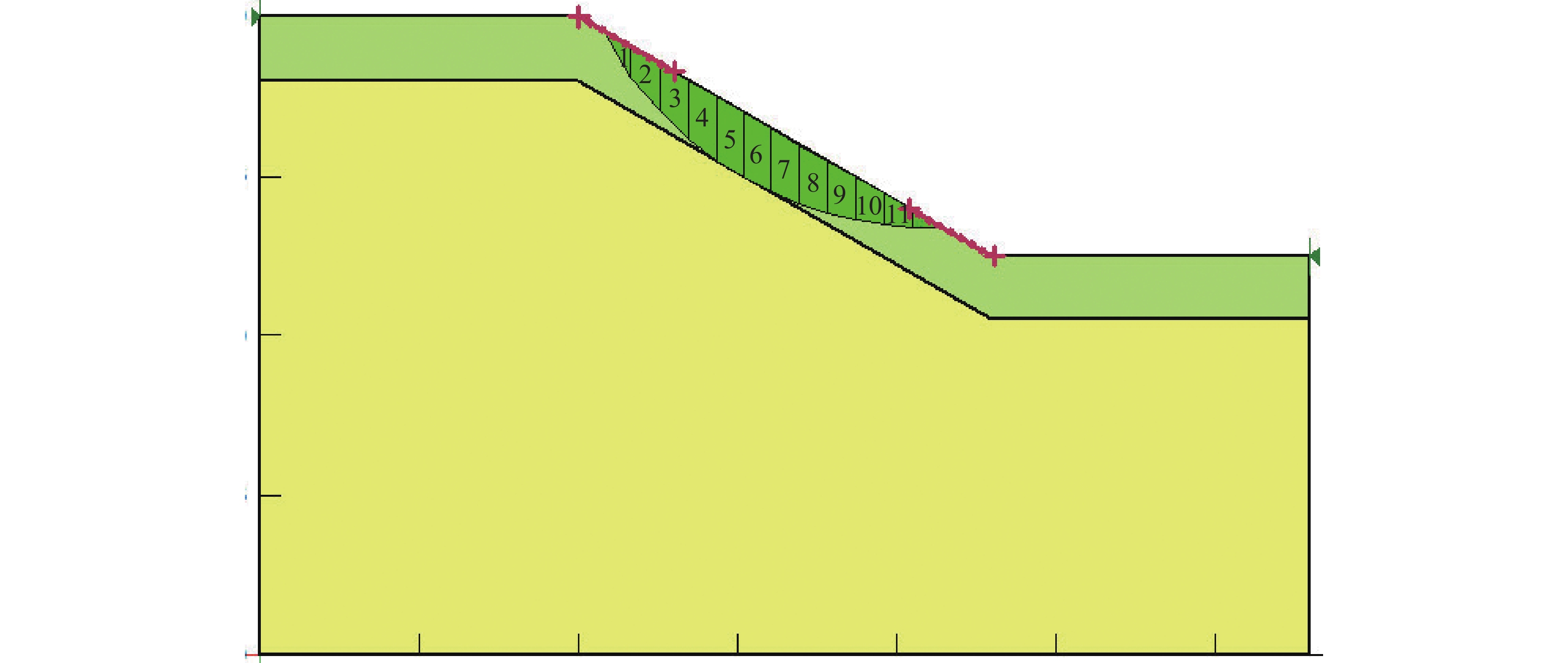The root anchorage effect of shrub species Caragana Korshinskii Kom. in the loess area of northeastern Qinghai–Tibet Plateau
-
摘要: 柠条锦鸡儿是青藏高原东北部黄土区主要的护坡和水土保持灌木,然而对该灌木根系锚固作用机理及其固土护坡效应方面仍缺乏系统性认识。鉴于此,该项研究在阐明柠条锦鸡儿根系锚固机理的基础上,提出了根系对黄土斜(边)坡浅层土体稳定性贡献计算模型。在此基础上,以研究区内生长期为11 a的柠条锦鸡儿为主要研究对象,通过现场根系挖掘试验、原位拉拔试验和理论分析,明确了假定滑动面条件下根系锚固力取值,并进一步定量评价了柠条锦鸡儿根系对黄土浅层滑坡稳定性的增强作用。结果表明:由于根系在地表没有“锚头”结构,故在确定滑动面几何特征的情况下,柠条锦鸡儿根系所能提供的实际锚固力大小取滑动面以下锚固段根系最大抗拔出力和滑动面以上根系锚固反力之间的最小值较为合理;生长期为11 a的单株柠条锦鸡儿根系锚固于最大厚度为2 m的圆弧形滑动面不同条块上时,潜在滑动面稳定性系数增幅为0.018%~0.427%,当单株根系锚固力作用于潜在滑动面中上部条块时,潜在滑动面稳定性系数相对高于根系锚固力作用于最顶部和下部条块;当4株柠条锦鸡儿根系以2块条块的间距(约3 m)作用于潜在滑动面时,潜在滑动面稳定性系数可提高1.035%~1.111%,显著高于(P<0.05,ANOVA)单株根系作用时的稳定性系数。试验株根系锚固作用能够提高降雨入渗条件下黄土斜(边)坡浅层土体稳定性,但是作用效果有限。Abstract: Shrub species Caragana korshinskii Kom. dominates slope protection and soil and water conservation in the loess area of the northeastern Qinghai–Tibet Plateau. However, the root anchoring mechanism and the effects of soil consolidation and slope protection of this shrub species remain unclear. This study aimed to elucidate the anchoring mechanism of roots of the C. korshinskii roots and establish a calculation model to evaluate their contribution to the stability of shallow loess slopes. C. korshinskii plants with an 11-year growth period were selected as the study subject. The anchoring force of C. korshinskii roots was determined through in-situ excavation tests, in-situ root pullout tests, and theoretical analysis, along with their impact on the stability of shallow loess soil slopes. The results showed that, due to the absence of a “bolt head” structure on the root surface, it was reasonable to consider the anchoring force provided by the roots as the minimum value between the maximum pullout resistance of the roots below the sliding surface and the anchoring reaction force of the roots above the sliding surface, based on the geometric characteristics of the sliding surface. When the roots of an 11-year-old C. korshinskii roots were anchored on different sliding blocks of a shallow landslide with a maximum thickness of 2 meters, the stability coefficient of the potential sliding surface increased by 0.020% to 0.408%. When the roots of a single plant were anchored in the middle and upper parts of the potential sliding surface, the stability coefficient of the potential sliding surface was relatively higher than when the plant roots were anchored at the top and bottom positions. Moreover, when four C. korshinskii roots were anchored to the shallow landslide with a row spacing of two sliding blocks (approximately 3 m), the stability coefficient of the potential sliding surface increased by 1.035% to 1.111%, which was significantly higher than when a single C. korshinskii root was anchored (P<0.05, ANOVA). The anchorage effect of the root systems could enhance the stability of shallow soil on loess slopes under rainfall infiltration conditions, but the effectiveness was limited.
-
0. 引言
青藏高原东北部位于中国东部季风半湿润区、西北内陆干旱区和青藏高原高寒区的交汇部,是气候与环境变化复杂而敏感的地区[1]。区内黄土广泛发育,且具有沉积厚度大、地层较完整等特征,特别是西宁盆地及其周边地区,是整个青藏高原东北部主要的黄土沉积区[2]。受新构造运动的影响,区内黄土侵蚀切割强烈,沟壑纵横,呈现梁、峁、塬和黄土丘陵等地貌景观[3]。由于西宁盆地及其周边地区降雨多为短时暴雨和阵雨,加之山麓斜坡坡度较大,植被覆盖度低,故降雨入渗深度相对较浅,导致盆地及其周边地区黄土浅层滑坡广泛发育,且具有分布规律性差、前期变形小、分布范围大、面小点多等特征,很难进行有效预测和提前防护,给区内黄土地区生态地质环境和工程安全带来严重威胁[4 − 6]。
植物通过力学效应和水文效应两方面作用,能够控制水土流失、浅层滑坡等地质灾害现象的发生[7 − 8]。植物固土护坡力学效应在于根系较土体而言具有显著较高的抗拉强度,当含有植物根系的土体受到剪切或张拉作用时,根系的存在能够将土体内部剪切滑动面上的剪应力和张裂面上的张应力转化为自身所承受的拉应力,并通过根-土界面剪应力将拉应力传递至稳定土体,从而起到增强土体抗剪强度和提高边坡稳定性的效果[9 − 12]。根系固土护坡力学效应可分为加筋和锚固两方面作用[13]。由于黄土浅层滑坡深度多为2~3 m[4, 6],而草本植物和幼龄木本植物的根系主要分布在地表以下1~1.5 m深度范围内[14 − 16],故对于大多数草本植物和幼龄木本植物而言,由于根系分布深度有限,因此主要起到加筋土体的作用,体现在增强根系分布层土体抗剪强度。而对于一些龄期较长的木本植物而言,根系能生长至深部土体,并足以穿过浅层滑坡滑动面,具有锚固浅层土体的作用[17 − 18]。因此,一般认为,大龄期木本植物根系锚固作用是实现区内黄土浅层滑坡生态防护的关键。
灌木林是青藏高原东北部黄土区主要的人工林和天然林类型,区内常见的灌木植物如柠条锦鸡儿(Caragana korshinskii Kom.)、柽柳(Tamarix chinensis Lour.)和沙棘(Hippophae rhamnoides Linn.)等[19 − 20]。这些灌木植物中,柠条锦鸡儿与同属的小叶锦鸡儿(Caragana microphylla Lam.)和甘蒙锦鸡儿(Caragana opulens Kom.)具有适应性强、抗寒耐旱、抗风蚀耐啃食和易繁殖等特性,是区内防风固沙、水土保持、荒山绿化以及高速公路护坡绿化的首选树种[21 − 23]。柠条锦鸡儿根系具有极强的向深层湿润土体延伸的特性[21 − 22],是典型的垂直根型植物,其主根明显,侧根发达,属于主侧根均衡发育型灌木[22]。胡崇礼[24]对生长于西宁盆地西山的柠条锦鸡儿根系分布特征进行了调查研究,结果表明生长期为18 a的柠条锦鸡儿根系深度可达7.0 m。因此,从根系分布特征的角度而言,柠条锦鸡儿等垂直根型灌木具有锚固斜(边)坡浅层土体的潜力。然而,目前有关植物锚固机理方面的研究,多是以植物原位拉拔试验、根系模型拉拔试验或根系拉拔过程数值模拟为基础,着重讨论根系抗拔出特性及其影响因素[25 − 31]。且已有的根系抗拔出试验中,根系是由地表垂直[25 − 31]或水平荷载作用下被拔出土体[27, 32]。这与浅层滑坡过程中,受滑坡下滑力作用下根系的实际受力状态存在区别。因为分布于滑动面上部和下部的根系受力方向实际上是不同的,且两部分根系在锚固土体过程中所发挥的作用亦不尽相同[33]。因此,拉拔试验所获得的根系抗拔出力更适合用于评价植物在风力和地表径流作用下的立地稳定性,而无法直接用于定量评价植物根系对斜(边)坡浅层土体稳定性的贡献。故在探讨植物根系锚固效应时,有必要先着手分析滑动面上下两部分根系的根-土相互作用过程,在此基础上,合理确定根系锚固力大小和计算模型,实现定量评价植物锚固作用对斜(边)坡浅层土体稳定性的贡献。
基于此,该项研究以广泛分布于青藏高原东北部黄土区的灌木柠条锦鸡儿为研究对象。首先阐明黄土浅层滑坡滑动时,分布于滑动面上下两部分的柠条锦鸡儿根系根-土相互作用力学过程,明确根系锚固机理,并进一步提出根系对斜(边)浅层土体稳定性贡献定量评价方法。以此为基础,以生长期为11 a的柠条锦鸡儿为试验对象,通过根系挖掘试验、根系原位拉拔试验和理论计算相结合的方法,合理确定假定滑动面条件下根系锚固力取值,并进一步定量评价了降雨入渗条件下,柠条锦鸡儿根系对黄土斜(边)浅层土体稳定性的增强作用。该项研究成果对于深入探讨灌木植物护坡力学机制,进一步实现合理利用植物有效地防治黄土地区水土流失、浅层滑坡等斜坡地质灾害具有理论指导意义和实际应用价值。
1. 柠条锦鸡儿根系锚固理论
1.1 柠条锦鸡儿根系锚固机理分析
植物根系锚固效应作用的对象是斜(边)坡浅层土体[13]。对于黄土斜(边)坡而言,浅层滑坡主要是降雨入渗诱发的[6, 18]。已有研究表明,黄土高原地区每年降水最大入渗深度为1~3 m左右,半湿润地区大丰水年份方可达到5 m以下[34]。而浅层滑坡深度多为2~3 m[4, 6]。在降雨入渗深度范围内,土体含水量增大导致浅层土体自重应力增大。与此同时,含水量增大能够显著降低黄土抗剪强度,从而诱发斜(边)坡浅层土体失稳滑动。
当植物根系分布深度大于浅层滑坡滑动面深度时,根系能够发挥其锚固作用[17 − 18]。图1所示为柠条锦鸡儿根系锚固黄土斜坡浅层土体的实例,以及黄土浅层滑坡发生时,柠条锦鸡儿根系根-土相互作用过程示意图。由图1(b)可知,当滑动面贯通滑体下滑或潜在滑动面局部发生蠕滑变形时,滑体和滑床将沿着滑动面发生相对错动,穿过滑动面的柠条锦鸡儿根系将承受拉应力,并通过根-土相互作用,将拉应力传递至根周土体(图1(b)假定根-土界面剪应力与拉拔力满足静力平衡条件,且已达到极限平衡状态)。位于滑动面上下两侧的根系所受拉应力方向均朝向滑动面,并在根-土界面产生背离滑动面的抗拔出力。虽然穿过滑动面的根系作用机理类似于全长粘结式锚杆,然而,由于根系在地表没有“锚头”结构,因此,滑动面上下两侧根系与土体之间的抗拔出力,实际为一对作用力与反作用力。为了便于区别,该项研究将滑动面以上根系受拉产生的背离滑动面的抗拔出力称为锚固反力,用Fj表示;将滑动面以下根系抗拔出力用Fm表示。根系锚固反力对于根系锚固斜(边)坡浅层土体具有重要意义。因为滑动面以上根系一旦与滑体分离,则将不再提供锚固反力,无法继续将滑坡下滑力传递至滑动面以下根系,从而导致锚固作用失效。也就是说,如果视滑动面以下的根系为锚固段,则锚固段根系所能提供锚固力的大小,在一定程度上取决于滑动面以上根系锚固反力的大小,反之亦然。综上所述,在滑动面一定的情况下,根系所能提供的实际锚固力大小为锚固段根系最大抗拔出力和滑动面以上根系锚固反力之间的最小值。由于黄土地区浅层滑坡主要受降雨入渗影响,因此滑动面以上属于降雨入渗区。入渗区内土体和根-土界面抗剪强度降低,根-土相互作用产生的抗拔出力相对于降雨入渗之前将显著下降。因此,降雨条件下滑动面以上根系锚固反力的大小,是评价根系锚固效果时需着重分析和考虑的条件。
1.2 柠条锦鸡儿根系对黄土斜(边)坡浅层土体稳定性贡献评价计算模型
该项研究在极限平衡理论基础上,参考《土钉支护技术规范》(GJB 5055—2006)[35]中边坡土钉支护普通条分法稳定性分析计算公式,提出考虑柠条锦鸡儿根系锚固作用条件下,斜(边)坡浅层土体稳定性计算式(1)。
$$ {F_{{{\rm{s}}}}}{{ = }}\frac{{\displaystyle\sum {\left[ {\left( {{W_{{i}}} + {Q_{{i}}}} \right)\cos {\alpha _{{i}}} \cdot \tan {\varphi _{{j}}} + \left( {{R_{{k}}}/{S_{{{{\rm{h}}k}}}}} \right)\sin {\beta _{{k}}} \cdot \tan {\varphi _{{j}}} + {c_{{j}}}\left( {{\varDelta _{{i}}}/\cos {\alpha _{{i}}}} \right) + \left( {{R_{{k}}}/{S_{{{{\rm{h}}k}}}}} \right)\cos {\beta _{{k}}}} \right]} }}{{\displaystyle\sum {\left[ {\left( {{W_{{i}}} + {Q_{{i}}}} \right)\sin {\alpha _{{i}}}} \right]} }} $$ (1) 式中:Fs——斜(边)稳定性系数;
Wi——土条i自重/kN;
Qi——作用于土条i的地面、地下载荷/kN;
αi——土条i圆弧破坏面切线与水平面的夹角/(°);
φj——土条i圆弧破坏面处第j层土的内摩擦角/(°);
Rk——穿过土条破坏面上第k排灌木根系所能提供的锚固力/kN,取锚固段根系抗拔出力Fm和滑动面以上根系锚固反力Fj的最小值;
Shk——第k排灌木根系的水平间距/m;
βk——第k排灌木根系锚固段轴线与该处破坏面切线之间的夹角/(°);
cj——土条i圆弧破坏面处第j层土的黏聚力/kPa;
$\varDelta _{{i}} $ ——土条宽度/m。滑动面以上根系锚固反力可由式(2)计算[36]。
$$ \begin{split} {F_{{j}}}&{\text{ = }}\int\limits_0^l {{\tau _{{\text{rs}}}}\text{π} D{\text{d}}\textit{z} }\\ &= \int\limits_0^l {({c_{{\text{rs}}}} + \tan {\varphi _{{\text{rs}}}}{K_0}\gamma l)\text{π} D{\text{d}}\textit{z} = } {c_{{\text{rs}}}}\text{π} Dl + \tan {\varphi _{{\text{rs}}}}{K_0}\text{π} D\gamma {l^2}/2 \end{split}$$ (2) 式中:Fj——锚固反力/kN;
τrs——根-土界面抗剪强度/kPa;
D——单根平均根径/m;
crs——根-土间黏聚力/kPa;
φrs——根-土间摩擦角/(°);
K0——静止土压力系数,取0.6;
γ——土体重度/(kN·m−3);
l——根系垂直埋置深度/m。
由此可知,在明确滑动面几何形态和滑动面以上柠条锦鸡儿根系特征的基础上,即可进行锚固反力计算。计算锚固反力时,结合柠条锦鸡儿侧根生长具有不确定性的实际情况,出于安全储备的角度,该项研究提出仅考虑由柠条锦鸡儿主根所贡献的锚固反力,而不考虑滑动面以上侧根对锚固反力的贡献。同时,以根系埋深代替主根实际长度进行锚固反力计算。因此,仅需明确柠条锦鸡儿根系主根在滑动面以上的平均根径和根-土界面抗剪强度指标,即可计算根系锚固反力。基于此,通过原位拉拔试验进一步确定滑动面以下根系抗拔出力数值,即可合理确定作用在滑动面上的根系锚固力取值,并通过式(1)计算出根系锚固作用条件下浅层滑坡稳定性系数。
2. 实例分析
2.1 假定滑动面以上柠条锦鸡儿根系分布特征与根周土体物理力学特性
试验区位于在青海省西宁市大有山,为天然黄土斜坡。试验区斜坡坡向向东,坡度22°~43°。试验区内生长的灌木柠条锦鸡儿属于人工灌木林。试验选取1株生长期为11 a(年龄通过年轮确定)的柠条锦鸡儿进行,采用原位挖掘法调查假定滑动面以上柠条锦鸡儿根系分布特征。考虑到黄土区浅层滑坡深度多为2~3 m。鉴于此,该项研究最初设定假定滑动面最大深度为地表以下2.5 m,该深度亦为此次原位根系挖掘调查的下限。但是,在实际挖掘过程中,受控于探坑施工空间和坑周排土空间,并考虑到坑周堆土稳定性,最终挖掘深度为2 m(假定滑动面最大深度亦改调整为2 m)。现场挖掘过程如图2所示。为了保证获得原位根系的准确信息,边挖掘边测量。现场测量的根系形态学指标包括根幅、主根长、主根根径和侧根根数、根长等。
表1为试验株地上植株和0~2 m深度范围内根系形态学指标统计数据。由该表可知,在0~2 m深度范围内,柠条锦鸡儿总根数达到27根,其中,除主根外还包括一级侧根20根,二级侧根和三级侧根各3根,主根平均根径为0.027 m。累计总根长34 m,根表面积0.87 m2,根幅为1.99 m。
表 1 试验株地上植株和根系形态学指标统计Table 1. Statistical analysis of morphological indexes of above-ground plants and root system above the hypothetical sliding surface of the testing plants植株及根系指标 树龄/a 冠幅/m 株高/m 总根数/根 根幅/m 一级侧根/根 二级侧根/根 三级侧根/根 主根平均根径/ m 总根长/m 根表面积/m2 取值 11 1.76 2.20 27 1.99 20 3 3 0.027 34 0.87 在根系调查的同时,按0.3 m间隔用环刀采集根周原状土体试样,每层采集4个试样,同时用铝土盒采集3个天然土试样。带回实验室后分别用于天然密度、抗剪强度指标和天然含水量测试。试验点植株根周土体物理力学特性如表2所示。深度范围为0~2 m
表 2 试验株根周土体物理力学特性Table 2. Physical and mechanical properties of root-soil interface of the testing plants物理力学性质 天然密度/(g·cm−2) 天然含水量/% 黏聚力/kPa 内摩擦角/(°) 取值 1.40±0.08 7.56±1.21 15.83±7.97 13.56±4.25 2.2 假定滑动面以下锚固段柠条锦鸡儿根系原位拉拔试验
通过现场挖掘表明,试验株分布于地表2 m以下深度的主根和侧根均属于垂直根系(垂直根系指根轴线与水平线夹角为60°~90°的根系[37]。因此,该项研究通过原位拉拔试验获得其抗拔出力。原位拉拔试验仪器采用自行设计加工的便携式野外拉拔仪,拉拔仪由支架、导链、拉力传感器(最大量程30 kN,精度0.5%)、拉线式位移传感器(最大量程1 m,精度0.5%)、数据采集系统、笔记本电脑组成,由蓄电池提供电源。拉拔试验时,首先将根系固定在导链下端挂钩上,然后人工匀速上拉导链(平均拉拔速率为21.50±3.71 cm/min),直到根系拉拔力超过峰值并达到位移量程极限时结束试验。试验过程中,数据采集系统将连续采集根系抗拔出力和对应的相对位移并在笔记本电脑终端软件页面显示,试验结束后,软件会自动保存此次试验相关数据。由于除主根外,试验株在地表2 m深度仍然有4根根系垂直向下生长。因此,共开展5次原位拉拔试验。
原位拉拔试验数据如表3所示。由表3可知,在地表以下2 m位置处,试验株垂直根系根径为0.005~0.020 m,抗拔出力为0.206~1.666 kN。拉拔试验过程中,5根根系并未被完整拔出土体,而是以根皮和木质部同时拉断的形式断裂。
表 3 试验株锚固段根系原位拉拔试验结果Table 3. In-situ pullout test results of root system in anchoring section of testing plants序号 抗拔出力/kN 拉拔端根径/m 断裂方式 1 0.206 0.007 根皮和木质部同时拉断 2 1.243 0.020 3 0.519 0.005 4 1.666 0.012 5 1.168 0.011 2.3 柠条锦鸡儿根系对黄土边坡浅层土体稳定性贡献评价
2.3.1 计算模型建立
在GeoStudio软件Slope/W模块中建立边坡模型(图3)。设置边坡坡度为30°,坡面长度为15 m,坡高为7.5 m。由于该项研究中假定滑动面深度、野外根系挖掘调查深度以及根系原位拉拔试验中根系出露深度均为地表以下2 m。因此,为获得最大深度为2 m的潜在滑动面,以便于进行柠条锦鸡儿根系锚固作用对黄土边坡浅层土体稳定性贡献评价,模型中设置地表以下2 m深度范围为降雨入渗区,且假设降雨入渗深度范围内土体处于饱和状态。由表2可知0~2 m深度范围内,试验株根周土体天然抗剪强度平均值为15.83±7.97 kPa和13.56°±4.25°。韩帅[38]的研究指出,原状黄土在饱和状态下的黏聚力与内摩擦角相对于其在天然含水量状态下的黏聚力和内摩擦角分别降低了47.5%和7.7%,基于此,该项研究中,饱和土体抗剪强度指标分别取8.31 kPa和12.51°。饱和重度取17.7 kN/m3。模型中入渗层下部非饱和土体物理力学参数采用表2中所示的0~2 m深度范围内土体物理力学参数。采用Morgenstern-Price法获得边坡潜在滑动面位置和滑体各条块特征参数。由图3所示,边坡潜在滑动面为圆弧形,滑动面最大深度与降雨入渗深度一致。
2.3.2 根系锚固反力计算与锚固力取值
由于黄土处于饱和状态时,土体黏聚力和内摩擦角降低幅度较大,加之根和根周土体弹性模量存在较大差异,故此时根-土界面破坏基本为根周土体剪切破坏[39]。因此,在降雨工况下,根系锚固反力计算时,根-土界面黏聚力和内摩擦角亦选择饱和黄土抗剪强度指标。该项研究结合边坡模型潜在滑动面条块特征,分别计算了试验株生长在不同条块中心轴线位置处的锚固反力数值,具体计算参数和结果如表4所示。
表 4 试验株生长于不同条块时锚固反力计算参数与结果Table 4. Calculation parameters and results of anchoring reaction force of testing plants growing on different blocks条块号 根-土间黏聚力/kPa 根-土间摩擦角/(°) 单根平均根径/m 根系垂直埋置深度/m 静止土压力系数 土体重度/(kN·m−3) 锚固反力/kN 1 8.31 12.51 0.040 0.461 0.6 17.7 0.513 2 8.31 12.51 0.033 1.204 0.6 17.7 1.207 3 8.31 12.51 0.029 1.655 0.6 17.7 1.546 4 8.31 12.51 0.027 1.912 0.6 17.7 1.709 5 8.31 12.51 0.027 2.000 0.6 17.7 1.805 6 8.31 12.51 0.027 2.000 0.6 17.7 1.805 7 8.31 12.51 0.027 1.930 0.6 17.7 1.729 8 8.31 12.51 0.029 1.748 0.6 17.7 1.650 9 8.31 12.51 0.033 1.485 0.6 17.7 1.529 10 8.31 12.51 0.033 1.147 0.6 17.7 1.141 11 8.31 12.51 0.036 0.737 0.6 17.7 0.762 12 8.31 12.51 0.040 0.257 0.6 17.7 0.278 注:表中单根平均根径取对应条块滑动面深度范围内主根平均根径;根系垂直埋置深度取值为对应条块滑动面深度,即滑动面中间点至地表的距离。 如前文所述,根系实际作用于滑动面上的锚固力应取滑动面以下锚固段根系最大抗拔出力和滑动面以上根系锚固反力的最小值。由原位拉拔试验实际测量数据显示,在地表以下2 m位置处,试验株5根垂直单根之间最大水平间距为0.65 m,故可同时作用于边坡模型中的同一块条块滑动面上。因此,试验株根系在深度为2 m的滑动面上所能提供的抗拔出力合力为4.802 kN。由表4可知,边坡模型潜在滑动面第5和6号滑块对应的滑动面深度最大,均为2 m。因此,试验株根系作用于这两块条块上的锚固段根系抗拔出力为4.802 kN。与此同时,第5和6号滑块对应的根系锚固反力均为1.805 kN,小于滑动面下部锚固段根系抗拔出力。相比之下,其他各条块滑动面深度均有所降低,而对应的根系锚固反力也随之降低。与此同时,由于滑动面以下根系埋深增加,故其他各条块滑动面以下根系抗拔出力理论上会相应增大。因此,在该项研究中,单株柠条锦鸡儿根系作用于各条块时,滑动面以上根系锚固反力均低于锚固段根系抗拔出力。因此,在计算根系锚固作用下边坡潜在滑动面稳定性系数时,锚固力取各条块对应的根系锚固反力值。
2.3.3 柠条锦鸡儿根系锚固作用条件下边坡潜在滑动面稳定性系数
采用式(1)计算无根系锚固作用和有根系锚固作用条件下模型边坡潜在滑动面稳定性系数。其中,有根系锚固作用条件下潜在滑动面稳定性系数计算时,首先计算单株根系锚固力分别作用于1~12号条块时,边坡潜在滑动面稳定性系数。在此基础上,进一步计算多株根系同时作用条件下,边坡潜在滑动面稳定性系数。经过野外测量,柠条锦鸡儿沿斜坡倾向方向行间距约为3~4 m,因此,在计算多株根系锚固作用条件下边坡潜在滑动面稳定性系数时,设计三组植株分布情况,每组中植株间距2块条块(约3 m)。即A组:植物根系作用于1、4、7和10号条块、B组:作用于2、5、8和11号条块以及C组:作用于3、6、9和12号条块。
各条件下边坡潜在滑动面稳定性系数计算结果如表5所示。由表5可知,通过式(1)计算得到的无根系锚固作用条件下边坡潜在滑动面稳定性系数为1.3370。当单株根系锚固于潜在滑动面不同条块上时,潜在滑动面稳定性系数均有提高,但增幅有限,为0.018%~0.427%。其中,当根系锚固力作用于潜在滑动面第4块条块时,潜在滑动面稳定性系数最大,为1.3427。当根系锚固力作用于潜在滑动面中上部位置处(2~7号)的条块时,潜在滑动面稳定性系数相对高于根系锚固力作用于最顶部(1号)和下部位置处(8~12号)条块的稳定性系数。这主要与条块下滑力大小、对应的锚固反力大小和βk值大小存在关系。由表5亦可知,当4株柠条锦鸡儿根系等间距锚固于潜在滑动面时,不同组合条件下边坡潜在滑动面稳定性系数为1.3508~1.3519,较无根系锚固作用条件下增长1.035%~1.111%,且显著高于(P<0.05,ANOVA)单株根系作用时对应的稳定性系数。总体而言,试验株根系锚固作用能够提高降雨入渗条件下黄土斜(边)坡浅层土体稳定性,但是作用效果有限。
表 5 柠条锦鸡儿根系锚固作用下边坡潜在滑动面稳定性系数计算结果Table 5. Calculation results of stability coefficient of potential sliding surface in the C. korshinskii roots system anchored slope锚固力作用
条块号土条
自重
/kPa土条
宽度
/m圆弧破坏面切线与
水平面的夹角/(°)根系锚固段轴线与
该处破坏面切线
之间的夹角/(°)根系水平
间距/m圆弧破坏面
处土体内
摩擦角/(°)圆弧破坏面处
土体黏聚力
/kPa根系锚
固力/kN稳定性
系数增幅/% 1 7.374 0.903 57.966 32.034 2 12.510 8.310 0.513 1.3391 0.156 2 19.252 0.903 50.216 39.784 2 12.510 8.310 1.207 1.3417 0.349 3 26.465 0.903 43.601 46.399 2 12.510 8.310 1.546 1.3426 0.417 4 30.577 0.903 37.659 52.341 2 12.510 8.310 1.709 1.3427 0.427 5 29.967 0.839 32.352 57.648 2 12.510 8.310 1.805 1.3425 0.414 6 29.967 0.839 27.531 62.469 2 12.510 8.310 1.805 1.3420 0.378 7 30.434 0.891 22.776 67.224 2 12.510 8.310 1.729 1.3413 0.324 8 27.560 0.891 18.043 71.957 2 12.510 8.310 1.650 1.3406 0.272 9 23.414 0.891 13.435 76.565 2 12.510 8.310 1.529 1.3399 0.217 10 18.082 0.891 8.914 81.086 2 12.510 8.310 0.513 1.3388 0.134 11 11.619 0.891 4.449 85.551 2 12.510 8.310 1.207 1.3379 0.071 12 4.055 0.891 0.010 89.990 2 12.510 8.310 1.546 1.3372 0.018 A - - - - - - - - 1.3510 1.047 B - - - - - - - - 1.3519 1.111 C - - - - - - - - 1.3508 1.035 对照 - - - - - - - - 1.3370 - 注:该项研究根系所能提供的锚固力取值为试验株根系单株作用在各条块时对应的锚固反力,并假设锚固力方向铅垂向下,故灌木根系锚固段轴线与该处破坏面切线之间的夹角为滑块滑动面切线与铅垂方向的夹角;灌木根系的水平间距取值由野外实际测量数据确定。 值得一提的是,该项研究在计算根系锚固反力时,出于安全储备仅考虑了主根而未考虑侧根对锚固反力的贡献。且以根系埋深代替单根实际长度进行锚固反力计算。虽然计算结果在理论上低于试验株根系对模型边坡潜在滑动面稳定性的真实贡献,相对较为保守,但是其结果在一定程度上依然能够反映该年龄段柠条锦鸡儿根系锚固作用对降雨条件下黄土斜(边)坡浅层土体稳定性的作用效果。与此同时,该设定亦可以简化分析和计算过程,便于定量评价柠条锦鸡儿及其他垂直根型植物对降雨型黄土浅层滑坡稳定性的贡献。此外,该项研究仅以生长期为11 a,处于中龄期[40]的灌木柠条锦鸡儿作为研究对象。由于植物根系生长特征是随着其生长期的增长而不断变化的,随着生长期增大,植物垂直根系和水平根系数量、长度、根径以及根-土界面抗剪特性还会进一步变化。故随着龄期变化,根系实际作用于斜(边)坡浅层土体的锚固力和锚固效果势必存在动态变化的特性。因此,掌握植物在特定气候土壤条件区域内根系随龄期变化的生长特征,是明确其根系固土护坡效应动态规律,科学合理利用植物有效地防治斜(边)浅表层土体地质灾害的基础。
3. 结论
(1)由于根系在地表没有“锚头”结构,故在确定滑动面几何特征的情况下,根系所能提供的实际锚固力大小取滑动面以下锚固段根系最大抗拔出力和滑动面以上根系锚固反力之间的最小值较为合理。
(2)生长期为11 a的单株柠条锦鸡儿根系锚固于最大厚度为2 m的圆弧形滑动面不同条块上时,潜在滑动面稳定性系数增幅为0.018%~0.427%;当4株柠条锦鸡儿根系以2块条块的间距(约3 m)作用于潜在滑动面时,潜在滑动面稳定性系数可提高1.035%~1.111%,显著高于(P<0.05,ANOVA)单株根系作用时的稳定性系数。试验株根系锚固作用能够提高降雨入渗条件下黄土斜(边)坡浅层土体稳定性,但是作用效果有限。
该项研究成果对于研究区采用垂直根型灌木植物进行浅层滑坡等地质灾害现象的生态防护,以及对进一步探讨根-土相互作用机制具有实际指导意义和理论研究价值。
-
表 1 试验株地上植株和根系形态学指标统计
Table 1 Statistical analysis of morphological indexes of above-ground plants and root system above the hypothetical sliding surface of the testing plants
植株及根系指标 树龄/a 冠幅/m 株高/m 总根数/根 根幅/m 一级侧根/根 二级侧根/根 三级侧根/根 主根平均根径/ m 总根长/m 根表面积/m2 取值 11 1.76 2.20 27 1.99 20 3 3 0.027 34 0.87 表 2 试验株根周土体物理力学特性
Table 2 Physical and mechanical properties of root-soil interface of the testing plants
物理力学性质 天然密度/(g·cm−2) 天然含水量/% 黏聚力/kPa 内摩擦角/(°) 取值 1.40±0.08 7.56±1.21 15.83±7.97 13.56±4.25 表 3 试验株锚固段根系原位拉拔试验结果
Table 3 In-situ pullout test results of root system in anchoring section of testing plants
序号 抗拔出力/kN 拉拔端根径/m 断裂方式 1 0.206 0.007 根皮和木质部同时拉断 2 1.243 0.020 3 0.519 0.005 4 1.666 0.012 5 1.168 0.011 表 4 试验株生长于不同条块时锚固反力计算参数与结果
Table 4 Calculation parameters and results of anchoring reaction force of testing plants growing on different blocks
条块号 根-土间黏聚力/kPa 根-土间摩擦角/(°) 单根平均根径/m 根系垂直埋置深度/m 静止土压力系数 土体重度/(kN·m−3) 锚固反力/kN 1 8.31 12.51 0.040 0.461 0.6 17.7 0.513 2 8.31 12.51 0.033 1.204 0.6 17.7 1.207 3 8.31 12.51 0.029 1.655 0.6 17.7 1.546 4 8.31 12.51 0.027 1.912 0.6 17.7 1.709 5 8.31 12.51 0.027 2.000 0.6 17.7 1.805 6 8.31 12.51 0.027 2.000 0.6 17.7 1.805 7 8.31 12.51 0.027 1.930 0.6 17.7 1.729 8 8.31 12.51 0.029 1.748 0.6 17.7 1.650 9 8.31 12.51 0.033 1.485 0.6 17.7 1.529 10 8.31 12.51 0.033 1.147 0.6 17.7 1.141 11 8.31 12.51 0.036 0.737 0.6 17.7 0.762 12 8.31 12.51 0.040 0.257 0.6 17.7 0.278 注:表中单根平均根径取对应条块滑动面深度范围内主根平均根径;根系垂直埋置深度取值为对应条块滑动面深度,即滑动面中间点至地表的距离。 表 5 柠条锦鸡儿根系锚固作用下边坡潜在滑动面稳定性系数计算结果
Table 5 Calculation results of stability coefficient of potential sliding surface in the C. korshinskii roots system anchored slope
锚固力作用
条块号土条
自重
/kPa土条
宽度
/m圆弧破坏面切线与
水平面的夹角/(°)根系锚固段轴线与
该处破坏面切线
之间的夹角/(°)根系水平
间距/m圆弧破坏面
处土体内
摩擦角/(°)圆弧破坏面处
土体黏聚力
/kPa根系锚
固力/kN稳定性
系数增幅/% 1 7.374 0.903 57.966 32.034 2 12.510 8.310 0.513 1.3391 0.156 2 19.252 0.903 50.216 39.784 2 12.510 8.310 1.207 1.3417 0.349 3 26.465 0.903 43.601 46.399 2 12.510 8.310 1.546 1.3426 0.417 4 30.577 0.903 37.659 52.341 2 12.510 8.310 1.709 1.3427 0.427 5 29.967 0.839 32.352 57.648 2 12.510 8.310 1.805 1.3425 0.414 6 29.967 0.839 27.531 62.469 2 12.510 8.310 1.805 1.3420 0.378 7 30.434 0.891 22.776 67.224 2 12.510 8.310 1.729 1.3413 0.324 8 27.560 0.891 18.043 71.957 2 12.510 8.310 1.650 1.3406 0.272 9 23.414 0.891 13.435 76.565 2 12.510 8.310 1.529 1.3399 0.217 10 18.082 0.891 8.914 81.086 2 12.510 8.310 0.513 1.3388 0.134 11 11.619 0.891 4.449 85.551 2 12.510 8.310 1.207 1.3379 0.071 12 4.055 0.891 0.010 89.990 2 12.510 8.310 1.546 1.3372 0.018 A - - - - - - - - 1.3510 1.047 B - - - - - - - - 1.3519 1.111 C - - - - - - - - 1.3508 1.035 对照 - - - - - - - - 1.3370 - 注:该项研究根系所能提供的锚固力取值为试验株根系单株作用在各条块时对应的锚固反力,并假设锚固力方向铅垂向下,故灌木根系锚固段轴线与该处破坏面切线之间的夹角为滑块滑动面切线与铅垂方向的夹角;灌木根系的水平间距取值由野外实际测量数据确定。 -
[1] 张西营,马海州,谭红兵. 青藏高原东北部黄土沉积化学风化程度及古环境[J]. 海洋地质与第四纪地质,2004,24(2):43 – 47. [ZHANG Xiying,MA Haizhou,TAN Hongbing. Chemical weathering degree and paleoenvironment of loess deposition in the northeast of qinghai-tibet plateau,China[J]. Marine Geology & Quaternary Geology,2004,24(2):43 – 47. (in Chinese with English abstract) ZHANG Xiying, MA Haizhou, TAN Hongbing. Chemical weathering degree and paleoenvironment of loess deposition in the northeast of qinghai-tibet plateau, China[J]. Marine Geology & Quaternary Geology, 2004, 24(2): 43 – 47. (in Chinese with English abstract)
[2] 鹿化煜,王先彦,孙雪峰,等. 钻探揭示的青藏高原东北部黄土地层与第四纪气候变化[J]. 第四纪研究,2007,27(2):230 – 241. [LU Huayu,WANG Xianyan,SUN Xuefeng,et al. Loess stratigraphy and palaeoclimate changes during quaternary in northeastern Tibetan Plateau revealed by loess core[J]. Quaternary Sciences,2007,27(2):230 – 241. (in Chinese with English abstract) LU Huayu, WANG Xianyan, SUN Xuefeng, et al. Loess stratigraphy and palaeoclimate changes during quaternary in northeastern Tibetan Plateau revealed by loess core[J]. Quaternary Sciences, 2007, 27(2): 230 – 241. (in Chinese with English abstract)
[3] ZHUANG Jianqi,PENG Jianbing,WANG Gonghui,et al. Prediction of rainfall-induced shallow landslides in the Loess Plateau,Yan’an,China,using the TRIGRS model[J]. Earth Surface Processes and Landforms,2017,42(6):915 – 927. DOI: 10.1002/esp.4050
[4] 黄志全,何鹏. 用有效降雨量监测黄土边坡稳定性的研究[J]. 华北水利水电学院学报,2007,28(6):53 – 55. [HUANG Zhiquan,HE Peng. Research of slope stability on effective rainfall[J]. Journal of North China Institute of Water Conservancy and Hydroelectric Power,2007,28(6):53 – 55. (in Chinese with English abstract) HUANG Zhiquan, HE Peng. Research of slope stability on effective rainfall[J]. Journal of North China Institute of Water Conservancy and Hydroelectric Power, 2007, 28(6): 53 – 55. (in Chinese with English abstract)
[5] 孙毅. 西宁市黄土滑坡发育特征及稳定性分析——以小酉山滑坡为例[D]. 西安:长安大学,2013. [SUN Yi. The development characteristics and stability analysis of Xining loess landslide[D]. Xi’an:Changan University,2013. (in Chinese with English abstract) SUN Yi. The development characteristics and stability analysis of Xining loess landslide[D]. Xi’an: Changan University, 2013. (in Chinese with English abstract)
[6] 王磊,李荣建,杨正午,等. 强降雨作用下黄土陡坡开裂特性测试[J]. 吉林大学学报(地球科学版),2021,51(5):1338 – 1346. [WANG Lei, LI Rongjian, YANG Zhengwu, et al. Experimental study on cracking characteristics of loess steep slope under intensive rainfall[J]. Journal of Jilin University (Earth Science Edition), 2021, 51(5):1338 – 1346. (in Chinese with English abstract) WANG Lei, LI Rongjian, YANG Zhengwu, et al. Experimental study on cracking characteristics of loess steep slope under intensive rainfall[J]. Journal of Jilin University (Earth Science Edition), 2021, 51(5): 1338 – 1346. (in Chinese with English abstract)
[7] WU T H,MCKINNELL W P,SWANSTON D N. Strength of tree roots and landslides on Prince of Wales Island,Alaska[J]. Canadian Geotechnical Journal,1979,16(1):19 – 33. DOI: 10.1139/t79-003
[8] CHAU N L,CHU L M. Fern cover and the importance of plant traits in reducing erosion on steep soil slopes[J]. CATENA,2017,151:98 – 106. DOI: 10.1016/j.catena.2016.12.016
[9] 吴宏伟. 大气–植被–土体相互作用:理论与机理[J]. 岩土工程学报,2017,39(1):1 – 47. [WU Hongwei. Atmosphere-plant-soil interactions:theories and mechanisms[J]. Chinese Journal of Geotechnical Engineering,2017,39(1):1 – 47. (in Chinese with English abstract) DOI: 10.11779/CJGE201701001 WU Hongwei . Atmosphere-plant-soil interactions: theories and mechanisms[J]. Chinese Journal of Geotechnical Engineering,2017 ,39 (1 ):1 –47 . (in Chinese with English abstract) DOI: 10.11779/CJGE201701001[10] SCHWARZ M,COHEN D,OR D. Pullout tests of root analogs and natural root bundles in soil:Experiments and modeling[J]. Journal of Geophysical Research:Earth Surface,2011,116(F2):167 – 177.
[11] 刘银鹏,李同录,胡向阳,等. 陇东陕甘边界降雨水毁灾情调查与启示[J]. 中国地质灾害与防治学报,2022,33(3):77 – 83. [LIU Yinpeng,LI Tonglu,HU Xiangyang,et al. Investigation of water induced damages triggered by rainfall in East Gansu and the implications[J]. The Chinese Journal of Geological Hazard and Control,2022,33(3):77 – 83. (in Chinese with English abstract) LIU Yinpeng, LI Tonglu, HU Xiangyang, et al. Investigation of water induced damages triggered by rainfall in East Gansu and the implications[J]. The Chinese Journal of Geological Hazard and Control, 2022, 33(3): 77 – 83. (in Chinese with English abstract)
[12] 刘亚斌,胡夏嵩,余冬梅,等. 西宁盆地黄土区2种灌木植物根-土界面微观结构特征及摩擦特性试验[J]. 岩石力学与工程学报,2018,37(5):1270 – 1280. [LIU Yabin,HU Xiasong,YU Dongmei,et al. Microstructural features and friction characteristics of the interface of shrub roots and soil in loess area of Xining Basin[J]. Chinese Journal of Rock Mechanics and Engineering,2018,37(5):1270 – 1280. (in Chinese with English abstract) LIU Yabin, HU Xiasong, YU Dongmei, et al. Microstructural features and friction characteristics of the interface of shrub roots and soil in loess area of Xining Basin[J]. Chinese Journal of Rock Mechanics and Engineering, 2018, 37(5): 1270 – 1280. (in Chinese with English abstract)
[13] 周德培,张俊云. 植被护坡工程技术[M]. 北京:人民交通出版社,2003:62. [ZHOU Depei, ZHANG Junyun. Bio-geotechnical technology of vegetation[M]. Beijing:China Communications Press,2003:62. (in Chinese) ZHOU Depei, ZHANG Junyun. Bio-geotechnical technology of vegetation[M]. Beijing: China Communications Press, 2003: 62. (in Chinese)
[14] BEEK L P H,WINT J,CAMMERAAT L H,et al. Observation and simulation of root reinforcement on abandoned Mediterranean slopes[J]. Plant and Soil,2005,278(1/2):55 – 74.
[15] 陈世鐄. 中国北方草地植物根系[M]. 长春:吉林大学出版社,2001. [CHEN Shihuang. Root system of grassland plants in northern China[M]. Changchun:Jilin University Press,2001. (in Chinese) CHEN Shihuang. Root system of grassland plants in northern China[M]. Changchun: Jilin University Press, 2001. (in Chinese)
[16] VERGANI C,GIADROSSICH F,BUCKLEY P,et al. Root reinforcement dynamics of European coppice woodlands and their effect on shallow landslides:a review[J]. Earth-Science Reviews,2017,167:88-102. DOI: 10.1016/j.earscirev.2017.02.002
[17] STOKES A,ATGER C,BENGOUGH A G,et al. Desirable plant root traits for protecting natural and engineered slopes against landslides[J]. Plant and Soil,2009,324(1/2):1 – 30.
[18] 李同录,李颖喆,赵丹旗,等. 对水致黄土斜坡破坏模式及稳定性分析原则的思考[J]. 中国地质灾害与防治学报,2022,33(2):25 – 32. [LI Tonglu,LI Yingzhe,ZHAO Danqi,et al. Thoughts on modes of loess slope failure triggered by water infiltration and the principals for stability analysis[J]. The Chinese Journal of Geological Hazard and Control,2022,33(2):25 – 32. (in Chinese with English abstract) LI Tonglu, LI Yingzhe, ZHAO Danqi, et al. Thoughts on modes of loess slope failure triggered by water infiltration and the principals for stability analysis[J]. The Chinese Journal of Geological Hazard and Control, 2022, 33(2): 25 – 32. (in Chinese with English abstract)
[19] 王志涛. 青海省东部地区几种野生和引进树种育苗及造林技术研究[D]. 杨凌:西北农林科技大学,2009. [WANG Zhitao. The study on breeding and afforestation of several wild and introduction species at the eastern part of Qinghai Province[D]. Yangling:Northwest A & F University,2009. (in Chinese with English abstract) WANG Zhitao. The study on breeding and afforestation of several wild and introduction species at the eastern part of Qinghai Province[D]. Yangling: Northwest A & F University, 2009. (in Chinese with English abstract)
[20] 杨占武,喇臣梅,陈武生. 乡土植物在青海省高等级公路绿化中的应用[J]. 青海农林科技,2010,(4):64–67. [YANG Zhanwu,LA Chenmei,CHEN Wusheng. Applications on native plants in Qinghai highway greening[J]. Science and Technology of Qinghai Agriculture and Forestry,2010,(4):64–67. (in Chinese with English abstract) DOI: 10.3969/j.issn.1004-9967.2010.04.024 YANG Zhanwu, LA Chenmei, CHEN Wusheng . Applications on native plants in Qinghai highway greening[J]. Science and Technology of Qinghai Agriculture and Forestry,2010 , (4 ):64 –67 . (in Chinese with English abstract) DOI: 10.3969/j.issn.1004-9967.2010.04.024[21] 毕建琦,杜峰,梁宗锁,等. 黄土高原丘陵区不同立地条件下柠条根系研究[J]. 林业科学研究,2006,19(2):225 – 230. [BI Jianqi,DU Feng,LIANG Zongsuo,et al. Research on root system of caragana korshinskii at different site conditions in the hilly regions of loess plateau[J]. Forest Research,2006,19(2):225 – 230. (in Chinese with English abstract) BI Jianqi, DU Feng, LIANG Zongsuo, et al. Research on root system of caragana korshinskii at different site conditions in the hilly regions of loess plateau[J]. Forest Research, 2006, 19(2): 225 – 230. (in Chinese with English abstract)
[22] 牛西午,丁玉川,张强,等. 柠条根系发育特征及有关生理特性研究[J]. 西北植物学报,2003,23(5):860 – 865. [NIU Xiwu,DING Yuchuan,ZHANG Qiang,et al. Studies on the characteristics of caragana root development and some relevant physiology[J]. Acta Botanica Boreali-Occidentalia Sinica,2003,23(5):860-865. (in Chinese with English abstract) NIU Xiwu, DING Yuchuan, ZHANG Qiang, et al. Studies on the characteristics of caragana root development and some relevant physiology[J]. Acta Botanica Boreali-Occidentalia Sinica, 2003, 23(5): 860-865. (in Chinese with English abstract)
[23] 张文文,郭忠升,宁婷,等. 黄土丘陵半干旱区柠条林密度对土壤水分和柠条生长的影响[J]. 生态学报,2015,35(3):725 – 732. [ZHANG Wenwen,GUO Zhongsheng,NING Ting,et al. The effects of plant density on soil water and plant growth on semi-arid loess hilly region[J]. Acta Ecologica Sinica,2015,35(3):725-732. (in Chinese with English abstract) ZHANG Wenwen, GUO Zhongsheng, NING Ting, et al. The effects of plant density on soil water and plant growth on semi-arid loess hilly region[J]. Acta Ecologica Sinica, 2015, 35(3): 725-732. (in Chinese with English abstract)
[24] 胡崇礼. 青海高原干旱、半干旱地区几个灌木树种抗性生理研究初报[J]. 青海农林科技,1985(4):24 – 31. [HU Chongli. Preliminary report on resistance physiology of several shrub species in arid and semi-arid areas of Qinghai Plateau[J]. Science and Technology of Qinghai Agriculture and Forestry,1985(4):24 – 31. (in Chinese) HU Chongli. Preliminary report on resistance physiology of several shrub species in arid and semi-arid areas of Qinghai Plateau[J]. Science and Technology of Qinghai Agriculture and Forestry, 1985(4): 24 – 31. (in Chinese)
[25] DUPUY L,FOURCAUD T,STOKES A. A numerical investigation into the influence of soil type and root architecture on tree anchorage[J]. Plant and Soil,2005,278(1/2):119 – 134.
[26] MICKOVSKI S B,BENGOUGH A G,BRANSBY M F,et al. Material stiffness,branching pattern and soil matric potential affect the pullout resistance of model root systems[J]. European Journal of Soil Science,2007,58(6):1471 – 1481. DOI: 10.1111/j.1365-2389.2007.00953.x
[27] LIU Ying,JIA Zhiqing,GU Lan,et al. Vertical and lateral uprooting resistance of Salix matsudana Koidz in a riparian area[J]. The Forestry Chronicle,2013,89(2):162 – 168. DOI: 10.5558/tfc2013-033
[28] 常婧美,王桂尧,胡圣辉,等. 灌木根系几何特性对拉拔力影响的试验研究[J]. 水土保持通报,2018,38(6):67 – 73. [CHANG Jingmei,WANG Guiyao,HU Shenghui,et al. Experimental study on effects of geometric characteristics of shrub roots on pulling force[J]. Bulletin of Soil and Water Conservation,2018,38(6):67 – 73. (in Chinese with English abstract) CHANG Jingmei, WANG Guiyao, HU Shenghui, et al. Experimental study on effects of geometric characteristics of shrub roots on pulling force[J]. Bulletin of Soil and Water Conservation, 2018, 38(6): 67 – 73. (in Chinese with English abstract)
[29] SU Lijun,HU Bingli,XIE Qijun,et al. Experimental and theoretical study of mechanical properties of root-soil interface for slope protection[J]. Journal of Mountain Science,2020,17(11):2784-2795. DOI: 10.1007/s11629-020-6077-4
[30] ZHANG Chaobo,LIU Yating,LIU Pengchong,et al. Untangling the influence of soil moisture on root pullout property of alfafa plant[J]. Journal of Arid Land,2020,12(4):666 – 675. DOI: 10.1007/s40333-020-0017-6
[31] JI Xiaodong,CONG Xu,DAI Xianqing,et al. Studying the mechanical properties of the soil – root interface using the pullout test method[J]. Journal of Mountain Science,2018,15(4):882 – 893. DOI: 10.1007/s11629-015-3791-4
[32] ZHOU Yue,WATTS D,LI Yuhui,et al. A case study of effect of lateral roots of Pinus yunnanensis on shallow soil reinforcement[J]. Forest Ecology and Management,1998,103(2/3):107 – 120.
[33] 于淼. 土层锚杆受力机理的现场试验研究[D]. 南宁:广西大学,2005. [YU Miao. Research of experiment about mechanics of soil anchor subjecting to force on the spot[D]. Nanning:Guangxi University,2005. (in Chinese with English abstract) YU Miao. Research of experiment about mechanics of soil anchor subjecting to force on the spot[D]. Nanning: Guangxi University, 2005. (in Chinese with English abstract)
[34] 李玉山. 黄土高原森林植被对陆地水循环影响的研究[J]. 自然资源学报,2001,16(5):427 – 432. [LI Yushan. Effects of forest on water circle on the Loess Plateau[J]. Journal of Natural Resources,2001,16(5):427 – 432. (in Chinese with English abstract) LI Yushan. Effects of forest on water circle on the Loess Plateau[J]. Journal of Natural Resources, 2001, 16(5): 427 – 432. (in Chinese with English abstract)
[35] 中国人民解放军总参谋部. 中华人民共和国国家军用标准:土钉支护技术规范GJB 5055—2006[S]. 武汉:武汉大学出版社,2006. [General staff of the Chinese people’s Liberation Army. National military standard of the people's Republic of China:Technical specification for soil nailed support GJB 5055 – 2006[S]. Wuhan:Wuhan University Press,2006. (in Chinese) General staff of the Chinese people’s Liberation Army. National military standard of the people's Republic of China: Technical specification for soil nailed support GJB 5055 – 2006[S]. Wuhan: Wuhan University Press, 2006. (in Chinese)
[36] 刘亚斌,王芃,王舒,等. 灌木柠条锦鸡儿根—黄土状盐渍土界面相互作用力学特性[J]. 水土保持研究,2022,29(4):127 – 132. [LIU Yabin,WANG Peng,WANG Shu,et al. Mechanical properties of the interface interaction between caragana korshinskii kom. root and loess-like saline soil[J]. Research of Soil and Water Conservation,2022,29(4):127 – 132. (in Chinese with English abstract) LIU Yabin, WANG Peng, WANG Shu, et al. Mechanical properties of the interface interaction between caragana korshinskii kom. root and loess-like saline soil[J]. Research of Soil and Water Conservation, 2022, 29(4): 127 – 132. (in Chinese with English abstract)
[37] GHESTEM M,VEYLON G,BERNARD A,et al. Influence of plant root system morphology and architectural traits on soil shear resistance[J]. Plant and Soil,2014,377(1/2):43 – 61.
[38] 韩帅. 天水地区强降雨诱发黄土—泥岩滑坡机理实验研究[D]. 北京:中国地质科学院,2020. [HAN Shuai. Experimental study on the mechanism of loess-mudstone landslide induced by heavy rainfall in Tianshui area[D]. Beijing:Chinese Academy of Geological Sciences,2020. (in Chinese with English abstract) HAN Shuai. Experimental study on the mechanism of loess-mudstone landslide induced by heavy rainfall in Tianshui area[D]. Beijing: Chinese Academy of Geological Sciences, 2020. (in Chinese with English abstract)
[39] 张云伟,刘跃明,周跃. 云南松侧根摩擦型根土粘合键的破坏机制及模型[J]. 山地学报,2002,20(5):628 – 631. [ZHANG Yunwei,LIU Yueming,ZHOU Yue. Study for the destroy principle and model of the Yunnan pine’s lateral root-soil friction bond[J]. Journal of Mountain Research,2002,20(5):628-631. (in Chinese with English abstract) ZHANG Yunwei, LIU Yueming, ZHOU Yue. Study for the destroy principle and model of the Yunnan pine’s lateral root-soil friction bond[J]. Journal of Mountain Research, 2002, 20(5): 628-631. (in Chinese with English abstract)
[40] 程积民,万惠娥,王静,等. 半干旱区柠条生长与土壤水分消耗过程研究[J]. 林业科学,2005,41(2):37 – 41. [CHENG Jimin,WAN Huie,WANG Jing,et al. Growth of caragana korshinskii and depletion process of soil water in semi-arid region[J]. Scientia Silvae Sinicae,2005,41(2):37 – 41. (in Chinese with English abstract) CHENG Jimin, WAN Huie, WANG Jing, et al. Growth of caragana korshinskii and depletion process of soil water in semi-arid region[J]. Scientia Silvae Sinicae, 2005, 41(2): 37 – 41. (in Chinese with English abstract)
-
期刊类型引用(2)
1. 李丽华,刘文,白玉霞,王翠英,李双琴. 椰壳纤维-石灰协同作用改良黏土性能试验研究. 水文地质工程地质. 2025(01): 130-140 .  百度学术
百度学术
2. LIANG Shen,WANG Shu,LIU Yabin,PANG Jinghao,ZHU Haili,LI Guorong,HU Xiasong. Mechanism underlying the uprooting of taproot-type shrub species in the loess area of northeastern Qinghai-Xizang Plateau, China. Journal of Arid Land. 2024(10): 1426-1443 .  必应学术
必应学术
其他类型引用(0)





 下载:
下载:





 邮件订阅
邮件订阅 RSS
RSS